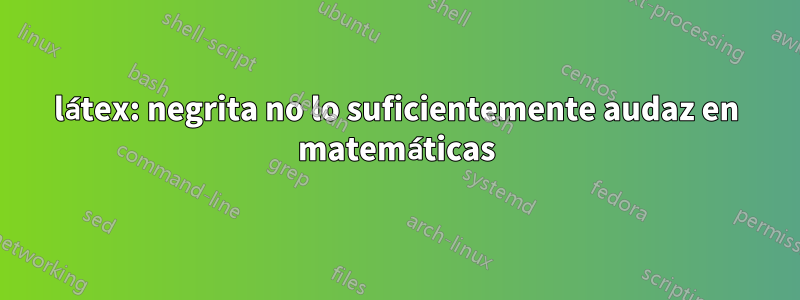
Intenté poner los caracteres en negrita en el entorno matemático para que se vieran así (imagen tomada de un libro, muestra en pdf:enlace):

Sin embargo, ninguno \mathbf{xyz}de los dos \boldsymbol{\mathrm{xyz}}funciona para que los personajes sean lo suficientemente audaces. De hecho, es difícil distinguir los caracteres en negrita de los que no lo son. Este es el código que probé:
\documentclass[english]{scrartcl}
\usepackage[T1]{fontenc}
\usepackage[latin9]{inputenc}
\usepackage{textcomp}
\usepackage{amstext}
\usepackage{babel}
\begin{document}
As an application of these results, consider the case in which $\mathbf{X}_{1}$
is $\mathbf{i}$, a constant term that is a column of 1s in the first
column of $\mathbf{X}$. The solution for $b_{2}$ in this case will
then be the slopes in a regression that contains a constant term.
Using Theorem 3.2 the vector of residuals for any variable in $\mathbf{X}_{2}$
in this case will be
$\mathbf{x\text{\textasteriskcentered}}=\mathbf{x}-\mathbf{X}_{1}(\mathbf{X}_{1}'\mathbf{X}_{1})^{-1}\mathbf{X}_{1}\mathbf{x}$
$\textrm{x\text{\textasteriskcentered}}=\textrm{x}-\textrm{X}_{1}(\textrm{X}_{1}'\textrm{X}_{1})^{-1}\textrm{X}_{1}\textrm{x}$
\end{document}
¿Existe algún truco para obtener caracteres "muy en negrita"?
BR Fabián
PD: He probado prácticamente todas las propuestas sobre cómo poner los personajes en negrita que he encontrado en Internet.
Respuesta1
El siguiente método sólo funciona en pdflatex. Utilizo un pdf especial para realzar la fuente, llamándolo \mathbbf[]{}. El argumento opcional permite especificar un factor de negrita opcional (predeterminado 0,2).
En el MWE, la línea superior es \mathbbf, la siguiente \mathbfy la final es \textrm.
\documentclass[english]{scrartcl}
\usepackage[T1]{fontenc}
\usepackage[latin9]{inputenc}
\usepackage{textcomp}
\usepackage{amstext}
\usepackage{babel}
%%%%%
\usepackage{scalerel,lmodern}
\input pdf-trans
\newbox\qbox
\def\usecolor#1{\csname\string\color@#1\endcsname\space}
\newcommand\outline[1]{\leavevmode%
\def\maltext{#1}%
\setbox\qbox=\hbox{\maltext}%
\boxgs{Q q 2 Tr \thickness\space w 0 0 0 rg 0 G}{}%
\copy\qbox%
}
\newcommand\mathbbf[2][.2]{%
\def\thickness{#1}%
\ThisStyle{\outline{$\mathbf{\SavedStyle#2}$}}%
}
%%%%%
\begin{document}
$\mathbbf{x\text{\textasteriskcentered}}=\mathbbf{x}-\mathbbf{X}_{1}(\mathbbf{X}_{1}'\mathbbf{X}_{1})^{-1}\mathbbf{X}_{1}\mathbbf{x}$
$\mathbf{x\text{\textasteriskcentered}}=\mathbf{x}-\mathbf{X}_{1}(\mathbf{X}_{1}'\mathbf{X}_{1})^{-1}\mathbf{X}_{1}\mathbf{x}$
$\textrm{x\text{\textasteriskcentered}}=\textrm{x}-\textrm{X}_{1}(\textrm{X}_{1}'\textrm{X}_{1})^{-1}\textrm{X}_{1}\textrm{x}$
\end{document}
Respuesta2
El contraste que existe entre la fuente en negrita y la mediana es un aspecto del diseño de la fuente. No has dado un documento de ejemplo. la computadora moderna predeterminada tiene un contraste razonable entre el peso medio y el negrita (lo cual es fácil ya que el peso medio cm es muy liviano)

\documentclass{article}
\usepackage{amsmath}
\begin{document}
$\mathbf{x}\text{\textasteriskcentered}=\mathbf{x}-\mathbf{X}_{1}(\mathbf{X}_{1}^{'}\mathbf{X}_{2}')^{-1}\mathbf{X}'_{1}\mathbf{x}$
$\mathrm{x}\text{\textasteriskcentered}=\mathrm{x}-\mathrm{X}_{1}(\mathrm{X}_{1}^{'}\mathrm{X}_{2}')^{-1}\mathrm{X}'_{1}\mathrm{x}$
\end{document}
Respuesta3
Una forma "sucia", que puede funcionar si usa látex fuera de la configuración de pdf y, por lo tanto, la respuesta de @Steven no se puede aplicar directamente, es usar \pmb{}desde el paquete AMSLatex, además del comando en negrita, posiblemente anidado varias veces.
A continuación puede ver v, \bm{v}, \pmb{\bm{v}}y \pmb{\pmb{\bm{v}}}para la salida Latex de la extensión TexMaths de LibreOffice, con la fuente tipo Palatino del newpxtextpaquete:




